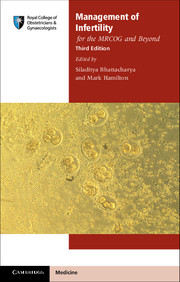Book contents
- Frontmatter
- Contents
- About the authors
- Preface
- Acknowledgements
- Abbreviations
- 1 Epidemiology and initial assessment
- 2 Male factor infertility
- 3 Ovulatory disorders
- 4 Tubal infertility
- 5 Endometriosis-related infertility
- 6 Uterine factors in infertility
- 7 Unexplained infertility
- 8 Assisted reproduction – preparation and work-up of couples
- 9 Assisted reproduction – clinical and laboratory procedures
- Index
2 - Male factor infertility
Published online by Cambridge University Press: 05 June 2014
- Frontmatter
- Contents
- About the authors
- Preface
- Acknowledgements
- Abbreviations
- 1 Epidemiology and initial assessment
- 2 Male factor infertility
- 3 Ovulatory disorders
- 4 Tubal infertility
- 5 Endometriosis-related infertility
- 6 Uterine factors in infertility
- 7 Unexplained infertility
- 8 Assisted reproduction – preparation and work-up of couples
- 9 Assisted reproduction – clinical and laboratory procedures
- Index
Summary
Introduction
The definition of male factor infertility is fraught with problems. At the simplest level, it only takes one sperm to fertilise one egg. However, ejaculated sperm have to find the cervix, traverse the cervical canal, swim through the uterine cavity, pick the correct fallopian tube and then reach its ampulla before finding the egg and fertilising it. Estimating a man's fertility is additionally complicated by the fact that there is a significant variation between sperm samples and, indeed, between the results obtained by different technicians analysing the same sample. Estimating a man's fertility is thus rather like putting ‘betting odds’ on his chances of becoming a father: the more healthy sperm there are the greater the chances of conception, but what is the lower limit at which a man has, in effect, no chance of fathering a child?
It is estimated that male factor problems are primarily responsible for up to 25% of cases of infertility and may be contributory in a further 20%. Assisted reproductive technology (ART) techniques such as intracytoplasmic sperm injection (ICSI) have revolutionised the treatment of infertility and allowed men with severe oligozoospermia, and many with azoospermia, to father their own children. Despite the success of such techniques, many of the underlying problems contributing to male infertility remain unidentified and unexplored.
Aetiology
The aetiology of male factor infertility is broadly divided into genetic and acquired causes. The genetic causes are proving particularly difficult to identify, although the azoospermia factor (AZF) region of the Y chromosome is certainly associated with some cases.
Keywords
- Type
- Chapter
- Information
- Management of Infertility for the MRCOG and Beyond , pp. 13 - 30Publisher: Cambridge University PressPrint publication year: 2014

